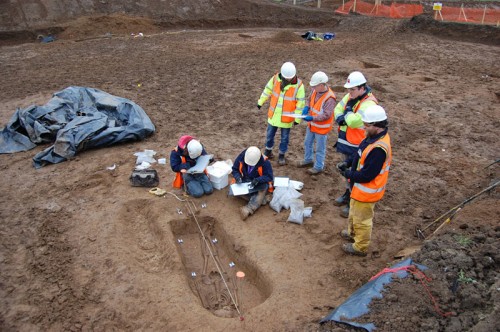Welcome to the website of the Archaeology of the East Kent Access Road.
We have been working on the site of the new road since October last year. To begin with, the route of the road was walked in a careful and systematic way and any finds (pottery, bone etc) visible on the surface of the ploughed fields were collected and recorded, test pits were hand excavated and local metal detectorists worked with the archaeological team to recover metal artefacts from the ploughsoil. All of the information gathered helped us to pinpoint the sites of ancient settlements buried beneath the ground.
Once these surveys had been completed, we began the process of carefully stripping off the topsoil with large earth-moving equipment. In the hands of a skilled operator, these machines remove topsoil extremely delicately, avoiding any damage to the archaeology beneath. We have now removed topsoil from an area of about 20 ha (the size of 20 football pitches) revealing the remains of Bronze Age barrows (burial mounds), Iron Age and Roman settlements and burials, and a medieval farmstead.
All of these remains are now being excavated by a team of around 90 Oxford Wessex Archaeology (OWA) archaeologists, working in all weather conditions. All of this work produces large quantities of written and drawn records and photographs along with bags and bags of finds (including pottery, bone and ancient building materials) and samples of soil from buried pits and ditches. All of this material is taken to the main site compound where the records are digitised and entered into our databases.

Once soil samples have been processed, the residues are sorted under a microscope to recover seeds, small animal bones and other remains.
At the compound, the finds are carefully washed and studied. Soil samples are processed and sifted through to recover seeds, grain and small animal bones, all of which help us to build up a picture of how and where are ancestors lived, what the environment was like and how it has changed over time. In other words, it helps us to write the history of the people who have lived, worked and died on Thanet through the ages.
This is an incredibly exciting project to work on and I hope that many of you will take the opportunity to come and work with us. There are a number of ways in which people can volunteer on the site, details of which can be found in the outreach section of this website.
If volunteering is not for you, we will also be giving talks and guided tours to local schools and other groups and will be organising a number of Open Days later in the year. And, of course, we will be updating this website with photos and reports from site as the excavation progresses.
Read more about the background to the project.






Place your comment